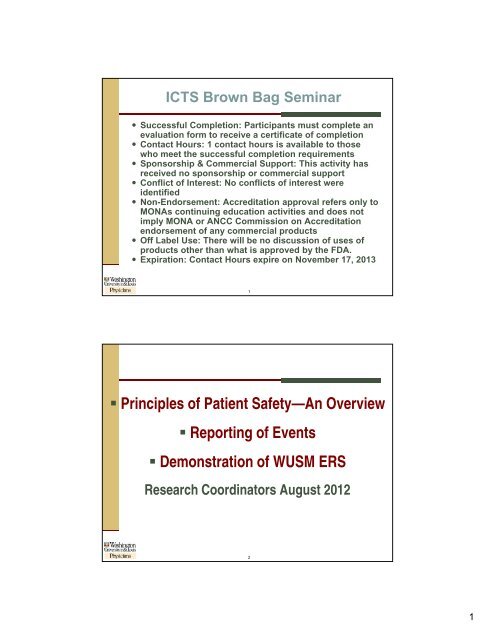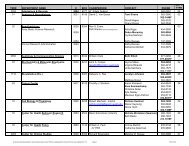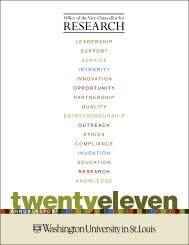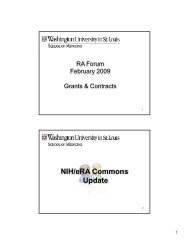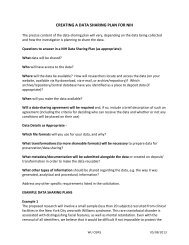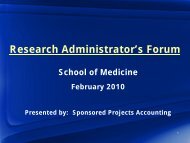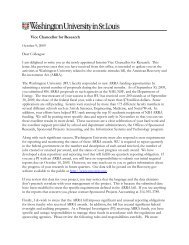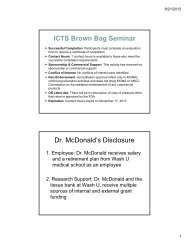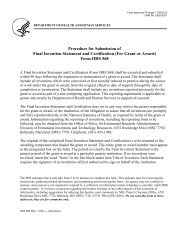evaluation form to receive a certificate of completion
evaluation form to receive a certificate of completion
evaluation form to receive a certificate of completion
You also want an ePaper? Increase the reach of your titles
YUMPU automatically turns print PDFs into web optimized ePapers that Google loves.
ICTS Brown Bag Seminar<br />
• Successful Completion: Participants must complete an<br />
<strong>evaluation</strong> <strong>form</strong> <strong>to</strong> <strong>receive</strong> a <strong>certificate</strong> <strong>of</strong> <strong>completion</strong><br />
• Contact Hours: 1 contact hours is available <strong>to</strong> those<br />
who meet the successful <strong>completion</strong> requirements<br />
• Sponsorship & Commercial Support: This activity has<br />
<strong>receive</strong>d no sponsorship or commercial support<br />
• Conflict <strong>of</strong> Interest: No conflicts <strong>of</strong> interest were<br />
identified<br />
• Non-Endorsement: Accreditation approval refers only <strong>to</strong><br />
MONAs continuing education activities and does not<br />
imply MONA or ANCC Commission on Accreditation<br />
endorsement <strong>of</strong> any commercial products<br />
• Off Label Use: There will be no discussion <strong>of</strong> uses <strong>of</strong><br />
products other than what is approved by the FDA.<br />
• Expiration: Contact Hours expire on November 17, 2013<br />
1<br />
• Principles <strong>of</strong> Patient Safety—An Overview<br />
• Reporting <strong>of</strong> Events<br />
• Demonstration <strong>of</strong> WUSM ERS<br />
Research Coordina<strong>to</strong>rs August 2012<br />
2<br />
1
Definition<br />
Patient Safety<br />
- Absence <strong>of</strong> preventable harm: avoidance <strong>of</strong> errors<br />
in clinical care resulting in injury <strong>to</strong> our patients<br />
3<br />
Harm—Scope <strong>of</strong> the Problem<br />
•More than 1 million preventable adverse<br />
events occur in the US each year<br />
•An estimated 44,000-98,000 people die in<br />
hospitals each year from preventable<br />
medical errors<br />
Institute <strong>of</strong> Medicine. 1999. To Err is Human: Building a safer health system.<br />
Many mark the release <strong>of</strong> To Err is Human by the Institute <strong>of</strong> Medicine as the first major<br />
study in patient safety and an attempt <strong>to</strong> <strong>of</strong>fer ideas on what can be done in prevention.<br />
The IOM <strong>to</strong>ok the Harvard study and extrapolated its findings <strong>to</strong> create the <strong>of</strong>ten quoted<br />
“44,000 – 98,000” statistic.<br />
4<br />
2
Yearly Attributable Deaths<br />
45,000<br />
40,000<br />
35,000<br />
30,000<br />
25,000<br />
20,000<br />
15,000<br />
10,000<br />
5,000<br />
0<br />
MVA Breast Cancer AIDS Medical Errors<br />
Even using the lower number from the IOM study, Medical Errors killed more<br />
Americans than car accidents and breast cancer. There is no indication that<br />
the annual rate <strong>of</strong> deaths from errors decreased since 1999.<br />
5<br />
AHRQ 2001<br />
High Pr<strong>of</strong>ile Deaths from Medical Errors<br />
Chemotherapy overdose<br />
Betsy Lehman, 39<br />
Dana Farber<br />
ABO compatibility<br />
checking error-- transplant<br />
Dehydration and oversedation<br />
Growth hormone<br />
overdose<br />
Josie King, 18 months<br />
Johns Hopkins<br />
Jesica Santillan, 17<br />
Duke<br />
6<br />
Sebastien Ferrero, 3<br />
U. Florida<br />
3
Traditional Approach <strong>to</strong> Error<br />
Personal responsibility and theory <strong>of</strong> “bad<br />
apples"<br />
• Error is a character flaw<br />
• Focus on the incident and the individual<br />
• Punishment and Remediation<br />
7<br />
Patient Safety Approach <strong>to</strong> Error<br />
• Humans make mistakes, even if we’re careful and well-intentioned. The<br />
goal <strong>of</strong> Patient Safety is not <strong>to</strong> eliminate human error, but <strong>to</strong> create safe<br />
systems <strong>to</strong> prevent them from reaching the patient.<br />
• Ask “How did it happen” not “Who did it’?<br />
• Systems or processes that depend on perfect human per<strong>form</strong>ance are<br />
fatally flawed.<br />
• Most adverse events result from a cascade <strong>of</strong> failures in a flawed<br />
system<br />
8<br />
4
Pioneers in Patient Safety<br />
“We can’t change<br />
the human<br />
condition, but<br />
we can change<br />
the conditions<br />
under which<br />
humans work.”<br />
9<br />
James Reasons’ “Swiss cheese” Model<br />
Some holes due<br />
<strong>to</strong> active failures<br />
Hazards<br />
Harm<br />
Other holes due <strong>to</strong><br />
latent system fac<strong>to</strong>rs<br />
Successive layers <strong>of</strong> defenses, barriers, & safeguards<br />
• No single individual error (active error) is sufficient <strong>to</strong> cause an accident<br />
• The majority <strong>of</strong> medical errors are caused by faulty systems, processes and<br />
conditions that lead people <strong>to</strong> make mistakes or fail <strong>to</strong> prevent them<br />
• Latent conditions = system faults that increase the probability <strong>of</strong> individuals making<br />
errors<br />
10<br />
5
Why has it taken so long <strong>to</strong> make things safer?<br />
• We don’t treat the delivery <strong>of</strong> healthcare as a science<br />
• Most errors don’t harm patients/failure <strong>to</strong> capture and learn<br />
-“no harm, no foul” usually brings a sigh <strong>of</strong> relief, not action<br />
• Need <strong>to</strong> overcome the culture <strong>of</strong> medicine which expects<br />
perfection instead <strong>of</strong> expecting error and planning for it<br />
-get away from the idea that your own effort drives everything<br />
-healthcare is a team sport: overwhelming evidence that diverse input<br />
improves outcomes<br />
• Some <strong>of</strong> us still believe smart people, working hard, will not<br />
make mistakes<br />
• We map the human genome and transplant hearts and lungs,<br />
but we don’t wash our hands<br />
11<br />
Human Fac<strong>to</strong>rs<br />
Examines activity by way <strong>of</strong> component tasks and<br />
considers it in terms <strong>of</strong>:<br />
Physical demands: fatigue, illness, substance abuse, stress<br />
Skill requirements: inexperience, fear, procedural shortcuts<br />
Mental workload: boredom, cognitive shortcuts, reliance on memory<br />
Team dynamics: stress, shift work<br />
Device design: equipment/programs<br />
Environment:<br />
fixed: lighting, heat, unnatural workflow space<br />
controllable: noise, interruptions, motion, clutter<br />
We know errors result when these fac<strong>to</strong>rs are violated<br />
12<br />
6
Human Fac<strong>to</strong>rs Principles<br />
• Avoid reliance on memory—seven digits is our max<br />
• Decrease reliance on vigilance<br />
• Increase verbal feedback/structured communication<br />
• Standardize what you can, and only that; use<br />
pro<strong>to</strong>cols & checklists wisely<br />
• Use constraints and forcing functions <strong>to</strong> create a<br />
safety net <strong>to</strong> save you from yourself<br />
• Reduce hand<strong>of</strong>fs and standardize content<br />
13<br />
When the posted speed limit is 65mph, how fast do you drive? What impacts your speed?<br />
•Time <strong>of</strong> day?<br />
•Whether it’s a speed trap?<br />
•Are you late picking up kids from daycare?<br />
•Is the weather bad?<br />
Even the best intentioned are pressed <strong>to</strong> step over known safety precautions in medicine, resulting<br />
in “practice creep”.<br />
14<br />
7
• Report<br />
How Do We Respond <strong>to</strong> Errors?<br />
—Report and Learn<br />
• Track and trend <strong>to</strong> learn<br />
• Devise strategies <strong>to</strong> build a better safety net <strong>to</strong><br />
prevent future events<br />
• Talk <strong>to</strong> each other openly and remember the<br />
substitution test<br />
15<br />
Traditional Voluntary Reporting in Hospitals<br />
Lost Opportunities <strong>to</strong> Learn from Physicians<br />
• Key Findings:<br />
Hospital staff did not report 86% <strong>of</strong> events <strong>to</strong> incident reporting systems<br />
Physician accounted for less than 2% <strong>of</strong> reports<br />
Hospital Incident Reporting Systems Do Not Capture Most Patient Harm. January<br />
2012 OEI-06-09-00091<br />
• Low physician reporting is problematic because it hinders the ability <strong>to</strong><br />
identify and mitigate risks. Physicians view health care through a unique<br />
lens, which allows them <strong>to</strong> identify certain types <strong>of</strong> hazards and certain<br />
contributing fac<strong>to</strong>rs better than others.<br />
Noble, DJ, Pronovost, Underreporting <strong>of</strong> Patient Safety Incidents Reduces Health<br />
Care’s Ability <strong>to</strong> Quantify and Accurately Measure Harm Reduction P. J Patient Saf 2010; 6:24<br />
16<br />
8
How <strong>to</strong> Build a Healthy Reporting Culture<br />
You Have <strong>to</strong> Start Somewhere/Anywhere<br />
□Teamwork<br />
□Open p communication<br />
□Management Support<br />
No blame but<br />
accountability<br />
Co-workers save others from<br />
learning first- hand errors<br />
Safety<br />
Culture<br />
Willing and able <strong>to</strong> report<br />
Observations are<br />
welcome and<br />
solicited<br />
Clinical changes visible<br />
and feedback frequent<br />
17<br />
What <strong>to</strong> Report?<br />
18<br />
9
Most Common Ambula<strong>to</strong>ry Events<br />
Which May Result in Harm<br />
•Failure <strong>to</strong> in<strong>form</strong> patient <strong>of</strong> clinically significant test result<br />
•Wrong test ordered or test not ordered when appropriate (ex: no HIV testing<br />
prenatally)<br />
•Wrong medication, wrong dose ordered, or medication not ordered when appropriate<br />
•Failure <strong>to</strong> moni<strong>to</strong>r high risk medication (ex: Warfarin/INR; Insulin)<br />
•Failure <strong>to</strong> notice dispensing errors (medication reconciliation not done)<br />
•Wrong treatment ordered<br />
•Tests ordered but not done<br />
•Errors arising during the per<strong>form</strong>ance <strong>of</strong> a clinical task<br />
•Wrong, delayed or missed diagnosis<br />
•Wrong treatment decision<br />
•Scheduling the wrong surgery or wrong site surgery<br />
•Errors in communication between physicians, services<br />
•Failure <strong>to</strong> respond <strong>to</strong> a consultation or communicate with referring physician<br />
resulting in delay or harm<br />
•Failure <strong>to</strong> schedule a test when requested by another service<br />
•Failure <strong>to</strong> moni<strong>to</strong>r tests ordered but not scheduled by patient<br />
19<br />
Siteman East Chemotherapy Infusion Map<br />
20<br />
10
OB Triggers<br />
‣ Maternal Mortality<br />
‣ Maternal cardiopulmonary arrest<br />
‣ Excessive maternal blood loss (roughly >1500cc)<br />
‣ Stillbirth <strong>of</strong> a baby admitted alive (excluding extreme prematurity or lethal anomalies)<br />
‣ Cord pH
When you learn <strong>of</strong> an event<br />
• Report it in the system at http://ers.wusm.wustl.edu<br />
• If the event is serious and harmed the patient, notify<br />
WUSM Risk Management at 362-6956, as you usually<br />
• Refer <strong>to</strong> WUSM ERS Guidelines for more in<strong>form</strong>ation<br />
23<br />
The type <strong>of</strong> thinking that got us in<strong>to</strong> these problems<br />
will not be the type <strong>of</strong> thinking that will get us out.<br />
Albert Einstein<br />
24<br />
12
Accessing the WUSM Event Reporting System<br />
Open Internet Explorer and navigate <strong>to</strong>:<br />
http://ers.wusm.wustl.edu<br />
• Your domain will create a shortcut on your desk<strong>to</strong>p or save the link <strong>to</strong><br />
your favorites.<br />
• If you are signed on <strong>to</strong> the secure WUSM computer network, you<br />
should not be prompted for your username and password.<br />
• WUSM ERS is optimized for Internet Explorer, Version 7.0 and above.<br />
Other web browsers, such as Firefox, Google Chrome, and Safari,<br />
can be used <strong>to</strong> enter events, but functionality is limited.<br />
• If you are not on the secure WUSM computer network, use Citrix or a<br />
Virtual Private Network (VPN) connection <strong>to</strong> access ERS.<br />
25<br />
Discussion<br />
26<br />
13


